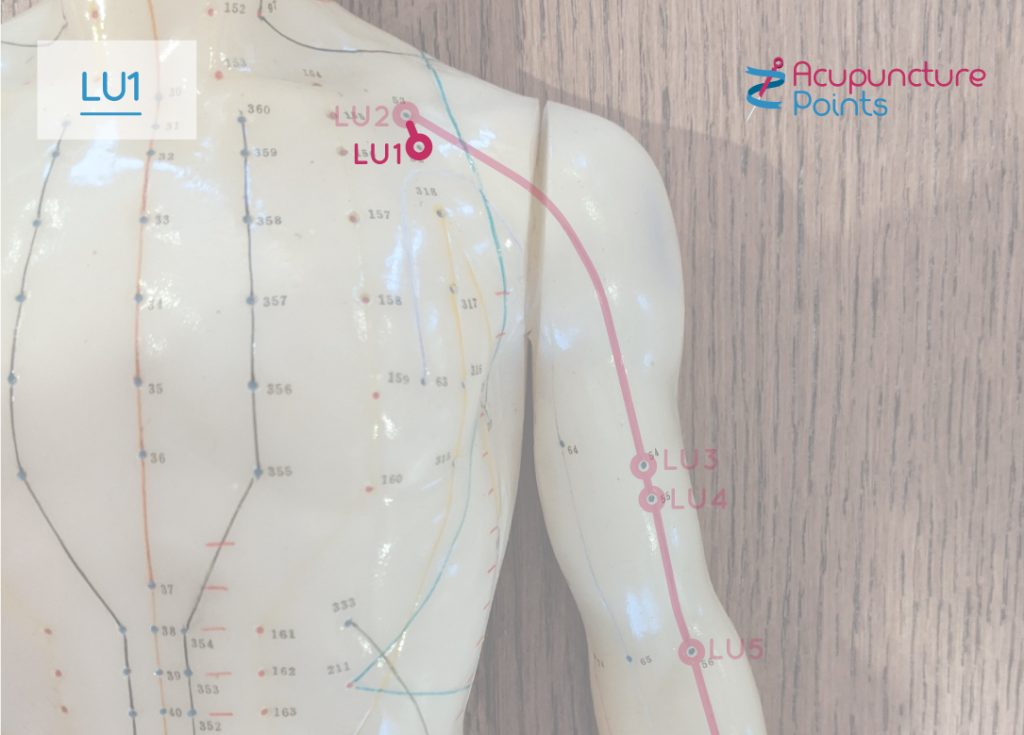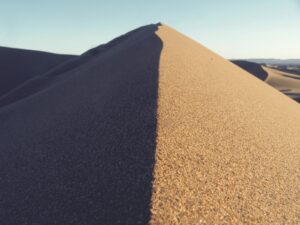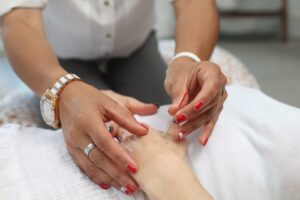Subscribe to the Newsletter
If you are interested in understanding how Traditional Chinese Medicine can improve your life sign up to my newsletter for the latest updates.

Lung point 1 is the first point on the surface of the skin of the Lung acupuncture channel.
Zhongfu is in the first intercostal space, about 1 unit (cun) inferior to the depression below the clavicle and medial to the coracoid process.
Notice that little word ‘about’! Usually the point is in the first intercostal space – between the first and second ribs, inferior to the depression below the clavicle and medial to the coracoid process, but sometimes it is level with the second rib.
If you need to use it, the point will nearly always be a bit sore when you press it, so find the sorest place and use that. However, if someone has sprained their shoulder, the whole area may be sore to pressure so then you’re back to working on gut instinct.
Needle depth is half to one cun.
Needle Lung point 1 transversely to the rib cage. What this means is that you should feel where the ribs are running and needle parallel to them. In practice, the ribs have turned in direction almost parallel to the side of the body at this point, ie almost at right angles to their direction across the front of the chest, so when you insert the needle it will be almost vertical to the skin at this point – but not quite!
Needle with caution! Needling too deeply or in the wrong direction can cause pneumothorax: be particularly careful with very thin patients, and not too confident with their opposites.
Sensation when needled can sometimes be felt across to the upper part of the chest.
Lung Zang problems from both external and internal pathogens, including from external invasion by wind-cold and wind-heat, like cough.
Also problems from internal causes like qi stagnation fullness, phlegm or phlegm-heat with thick phlegm such as in chronic bronchitis, pulmonary TB, chest pain and difficulty breathing. (Of course, if you’re treating serious conditions like these you would almost certainly need to get good deqi sensation to confirm you’d got the point and it was working. People in China are more used to this than us Western weaklings!)
Also for low Lung qi with difficulty breathing when lying, including such as in pleurisy, pneumonia and asthmatic wheezing.
Although Lung point 1 is the first external point of the Lung channel, in fact the Lung channel arises deep within the body in the region of the stomach, from which it descends to meet with the Large Intestine and then ascends via the cardiac orifice of the stomach, through the diaphragm and into the Lung zang, then up to the throat area and only then laterally to Lung 1.
The divergent branch of the Lung channel starts from the axilla area near Lung point 1, then sends one branch to the Heart channel in the chest and down through the Lung zang to the Large Intestine Zang.
Another branch ascends from the Lung zang through the supra-clavicular fossa to the throat where it combines with the Large Intestine channel and ascends to the nose.
Consequently the Lung zang energy is closely related to the Stomach fu energy.
In practice this means that
Equally, although the Lung channel doesn’t ascend directly to the nose, it does converge with the Large Intestine channel to go there, so many throat and nasal problems (eg blocked nose, nosebleed) can be regulated through points on the lung channel.
When there is stagnant Liver qi, and weak Lung qi, using Lung point 1 with the last point on the Liver channel (Liver 14), often releases the flow from the Liver channel and invigorates the Lung channel. Use it this way particularly if you have a sensation of congestion in the chest, or with people who are ‘stuffy’! It may help them to open up.
Lung point 1 can be very effective in clearing Lung fullness in the chest such as phlegm, damp and cold.
Its use as the entry point of the channel isn’t taught at all colleges. How well it works as an entry point depends on the relative energies in the Liver and Lung channels, on how well you locate the point, and on which of several possible locations you use for Liver 14.
Because the Lung meridian originates in the stomach region, it is also arguable that Conception Vessel points Ren 14 (Juque), 15 (Jiuwei), 16 (Zhongling), all of which lie in the region of the stomach, can also be used as ‘entry’ points. Each of them affects the chest, and Ren 15 (Jiuwei) not only descends Lung qi and unbinds the chest but is the Luo-connecting point for the Conception vessel giving it a reciprocal role to Lung 7, (Master point for the Conception vessel).
Ren 14 (Juque) in particular shares similar actions to Lung acupuncture point 1. So if opening the entry point for the Lung is the aim, I find that if using Lung acupuncture point 1 doesn’t make much difference, adding one or more of Ren 14, 15 or 16 usually completes the job.
You could argue that using Juque, Ren 14 also affects the Heart, since it is the front-Mu point of the Heart, and you might wish not to do this: true – but you could also argue that since the Lung and the Heart together occupy the upper burning space, they work together so it shouldn’t hurt to use one to help the other.
The same argument applies if you are treating the Heart channel and want assistance from the Lung – use Lung acupuncture point 1.
Indeed, if you’re feeling adventurous, why not use one needle technique and needle both Lung 1 and Heart 1 together? (But be careful! You may need to get deqi at Lung 1 first then gently withdraw somewhat and redirect the needle more laterally to find Heart 1. Again – be careful not to penetrate between the ribs into the pleura.)
When Lung qi is weak and there is no fullness (eg from phlegm) moxa on needle at this point is great, especially if combined with moxa at Ren 17 Shanzhong.
Lung point 9 is the tonification point of the Lung channel via the Five Element phase diagram. Sometimes this point isn’t appropriate but an alternative is Lung point 1, meeting point with the Spleen channel.
This whole area medial and inferior to the shoulder contains Spleen 21 and Heart 1, as well as other important points like Gall Bladder 22 Yuanye which isn’t so much used because the patient has to unrobe more, (and for women this point may mean loosening or removing the bra).
All these points here mentioned unbind the chest in one way or another as do other points in the region.
| Lung-1 | Zhongfu | Middle Mansion |
| Lung-2 | Yunmen | Cloud Gate |
| Lung-3 | Tianfu | Heavenly Palace |
| Lung-4 | Xiabai | Protecting White |
| Lung-5 | Chize | Foot Marsh |
| Lung-6 | Kongxui | Great Opening |
| Lung-7 | Lique | Broken Sequence |
| Lung-8 | Jingqu | Channel Gutter |
| Lung-9 | Taiyuan | Great Abyss |
| Lung-10 | Yujo | Fish Region |
| Lung-11 | Shaoshang | Lesser Shang |

Stay in Touch!
No spam, only notifications about new articles and updates.

Book a Video consultation if you want to know more about your symptoms

This Introductory Chinese medicine course introduces you to the amazing thinking behind this ancient medicine, now increasingly in demand.

The Scottish College for Chinese medicine provides introductory courses for all, explaining Chinese medicine and its cultural background.

Master Tung’s acupuncture is a hidden treasure, lost to China but recovered in Taiwan from where it spread round the world.

Knee pain has five main causes. It’s certainly worth trying acupuncture before you resort to surgery!
Subscribe to the Newsletter
If you are interested in understanding how Traditional Chinese Medicine can improve your life sign up to my newsletter for the latest updates.
Subscribe to the Newsletter
If you are interested in understanding how Traditional Chinese Medicine can improve your life sign up to my newsletter for the latest updates.